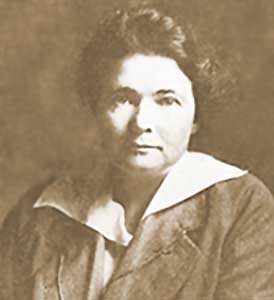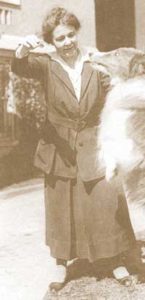
Nevada Historical Society, Reno
ANNE HENRIETTA MARTIN
The information below has been compiled from a variety of sources. If the reader has access to information that can be documented and that will correct or add to this woman’s biographical information, please contact the Nevada Women’s History Project.
At A Glance:
Born: September 30, 1875, Empire City, Nevada
Died: April 15, 1951, Carmel, California
Maiden Name: Baptized Anna Henrietta Martin; aka Annie
Race/Nationality/Ethnic Background: Caucasian (Irish, Bavarian)
Primary City and County of Residence and Work:
Reno, Washoe County
Major Fields of Work: Women’s suffrage movement, International peace, Rights of women and children.
Anne Henrietta Martin was the daughter of a very traditional Bavarian mother and an exceptionally open-minded Irish father. Christened Anna, she was called Annie in her youth and from about 1900 on was known as Anne. Her mother, Louise Stadtmiller Martin, cherished the most conservative of Victorian ideals, and taught a nursery school at home. Anne was well educated throughout her entire life and enjoyed physical comfort and intellectual stimulation.
At the age of eighteen, she wrote: “Will I never have any ambition, will I never accomplish anything…? O, I must do something. I suppose I should live more for others, but I don’t understand how. I must do something.”
Her father was a member of the Nevada Senate 1875-1879. He was involved in a mercantile store in Empire City, but moved the family to San Francisco in 1880 when the town declined. They returned to Reno in 1883 and built a house at the corner of Mill and Lake Street. He later became president of the Washoe County Bank, the Reno Water Company and the Reno Flour Mills.
Anne and her sisters attended Bishop Whittaker School for Girls. Anne was very spirited and in 1891 she and her classmates were told they would need an additional year instead of graduating. Instead, Anne enrolled in Nevada State University, where she tested as a sophomore. Three years later she had earned her B.A. degree at the age of 19. In two years at Leland Stanford Junior University she earned a B.A. in history and a year later an M.A. in history. She returned to Reno to found the Department of History at Nevada State University and was on the faculty there from 1897-1901.
 She took a leave of absence 1899-1901 and studied at the Universities of London, Leipzig and Columbia, and was a student at Chase’s Art School in New York City 1899-1900. She traveled and studied in Europe and the Orient in 1904-1907 and 1909-1911.
She took a leave of absence 1899-1901 and studied at the Universities of London, Leipzig and Columbia, and was a student at Chase’s Art School in New York City 1899-1900. She traveled and studied in Europe and the Orient in 1904-1907 and 1909-1911.
Anne Martin’s ten years of travel and study brought her to the cause of feminism. In England she associated with the Fabian Socialists and affiliated with the Women’s Social and Political Union (WSPU). She participated in political activism with Christabel and Emmeline Parkhurst and enjoyed the Lyceum Club activities.
In January 1910, she was arrested in Great Britain with 114 other women and four men. They were sent by the WSPU to the House of Commons to request the Prime Minister to give further facilities of the Conciliation Bill which would enfranchise British women to a limited extent. Herbert Hoover was sent by his wife, Lou Henry Hoover, Anne’s friend since Stanford days, to pay her bail. However, her bail had already been paid by Frederick Pethick-Lawrence, WSPU Treasurer.
In 1910, the Nevada Equal Franchise Society was established with the aid of Professor Jeanne Weir and the first suffrage legislation was passed by the Nevada Legislature. Anne Martin returned to Nevada and was elected president in 1912, with Bird Wilson as vice-president. Anne Martin organized the campaign that won women’s suffrage with the popular vote in Nevada on November 3, 1914, after passing the Legislature in 1911 and 1913.
She was a delegate to the Women’s International League for Peace and Freedom, member of the executive committee of the National American Woman Suffrage Association and elected national chairperson of the National Woman’s Party and the first Woman’s Party national convention in Chicago in June 1918. She was the first female member of the Nevada Educational Survey Commission in 1915.
Anne Martin was president of the Nevada Women’s Civic League. She was the author of numerous newspaper and magazine articles on political and economic subjects and women’s equality. She was also the first state woman tennis champion.
Anne Martin was an Independent candidate for the U.S. Senate from Nevada in 1918 and 1920. She wrote magazine articles about women’s equality. In 1919, in Good Housekeeping, she wrote, “The question we must have answered in the coming campaign is not “What shall women do for the political parties?” but “What shall the political parties do for women?””
In 1920, in Good Housekeeping, she wrote, “Last year our government spent $47,000 to protect farmers against avoidable losses of hogs, corn and cattle. In the same period it spent, in an effort to prevent the avoidable loss of mothers and babies, just $47,000 less. And we lost 250,000 babies and nearly 23,000 mothers died in childbirth. Such discrimination in favor of hogs and corn should cease.” Her powerful rhetoric definitely supported the adoption of the Sheppard-Towner law for protection of maternal and infancy cases.
She and her mother sold the house in Reno in 1921 and moved to Carmel, California. She wrote magazine articles about women’s equality and was an advocate for children. She participated in music club meetings, Democratic women’s gatherings and daily walks with her dog. She enjoyed physical comfort and intellectual stimulation.
Anne Martin advocated Farmer’s Markets, which would eliminate the wasteful cost of handling by middlemen. She was a member of the national board of the American Civil Liberties Union. Her writings during the next thirty years championed the causes of women and children. She continued to be active in the Women’s International League for Peach and Freedom (WILPD), and worked with Jane Addams on various issues. Her activities were curtailed for several years by a heart attack in 1930.
She campaigned for the Equal Rights Amendment. She wrote articles for the Encyclopedia Britannica; an article on Josephine Butler and one on the white slave traffic. In her later years, she spent much of her time in Reno, living at the Golden Hotel and using the Washoe County Library for research.
In recognition of Miss Martin’s leadership in the fight for state and national suffrage and her work in other fields, the University of Nevada in 1945 conferred upon her the degree of Doctor of Laws. The citation read, “Anne Henrietta Martin…native daughter, distinguished alumnus, student and scholar, inspiring teacher, disciple of world peace, pioneer in the triumphant struggle for women’s rights, leader of womankind…Doctor of Laws.”
Biographical sketch by Holly Van Valkenburgh
Sources of Information:
- Howard, Anne Bail. The Long Campaign: A Biography of Anne Martin. Reno, UNR Press, 1985.
- Basso, Dave, comp. Anne Martin, Pioneer Nevada Feminist: Selected Writings. Sparks, Falcon Hill Press, 1986.
- Shepperson, Wilbur S., ed. East of Eden, West of Zion: Essays on Nevada. Reno, UNR Press, 1989. pp. 61-63.
- Rocha, Guy. “Who Was the First Woman to Run for the U.S. Senate?”. Nevada State Archives, Historical Myth a Month, Myth # 47. http://dmla.clan.lib.nv.us/docs/nsla/archives/myth/myth47.htm.
- Smith, Ann Warren. “The Origins of Woman Suffrage”, in Stanley Paher,ed., Nevada: Official Bicentennial Book. Las Vegas: Nevada Publications, 1976.
- Sterry, Iveagh Hunt. “Miss Anne Martin, at 15, Pictures Life at Bishop Whittaker Academy”, State Journal, Jan. 24, 1954, p.?.
- Myers, Dennis. “A Rebel and a Cause”. Stanley W. Paher, ed., Nevada: Official Bicentennial Book. Las Vegas: Nevada Publications, 1976. p. 411-413.
